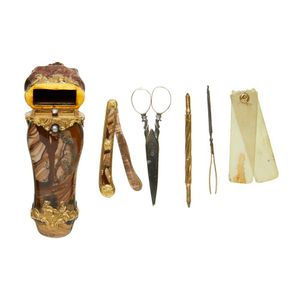French 19th Century Gold and Agate Etui
You must be a subscriber, and be logged in to view price and dealer details.
Subscribe Now to view actual auction price for this item
When you subscribe, you have the option of setting the currency in which to display prices to $Au, $US, $NZ or Stg.
- Putto / Putti / Amorino / Amorini - A putto (plural: putti) or amerino (plural: amerini) is a cherub or cupid frequently appearing in both mythological and religious paintings and sculpture, especially of the Renaissance and Baroque periods and later used as a decorative element in the design of furniture, ceramics, statuary etc. They are usually depicted as chubby males, or of indeterminate gender, often with wings. Their depiction may represent an association with love, heaven, peace or prosperity.
- Foliate - Decorated with leaves or leaf-like forms.
- Gilding - Gilding is a method of ornamentation whereby a thin sheet of gold metal is applied to items made of wood, leather, ceramics, glass and silver for decorative purposes.
For furniture including mirrors, the sheet of gold is usually applied over a coating of gesso. Gesso is a mixture of plaster of Paris and gypsum mixed with water and then applied to the carved wooden frames of mirrors and picture frames as a base for applying the gold leaf. After numerous coats of gesso have been applied, allowed to dry and then sanded a coat of "bole", a usually red coloured mixture of clay and glue is brushed on and allowed to dry, after which the gold leaf is applied. Over time parts of the gilding will rub off so the base colour can be seen. In water gilding, this was generally a blue colour, while in oil gilding, the under layer was often yellow. In Victorian times, gilders frequently used red as a pigment beneath the gold leaf.
Metal was often gilded by a process known as fire gilding. Gold mixed with mercury was applied and heated, causing the mercury to evaporate, the long-term effect of which was to kill or disable the craftsman or woman from mercury poisoning. The pursuit of beauty has claimed many victims, not the least of which were the artists who made those pieces so highly sought after today. - Agate - Agate is a type of semi-precious gemstone that is made up of silica dioxide, a mineral that is also found in quartz. It is known for its distinctive banded patterns, which are created as layers of silica are deposited in different colours including red, orange, yellow, green, blue, and purple. It is often used in jewellery, decorative objects, and other decorative items, and it is prized for its beauty and durability. Agate is found in many parts of the world, including Brazil, India, and the United States.
- Frieze - An architectural term denoting the flat, shaped or convex horizontal surface of furniture, between the architrave and the cornice, usually found on a cabinet or bookcase, or on desks and tables where it may include drawers, the area between the top and the legs. In ceramics, the term refers to the banding, of usually a repeating pattern, on the rims of plates and vases.
This item has been included into following indexes:
Visually similar items

Oribe Ikebana vase, Japanese c. 1960, tall cylindrical form with two handles and removable bamboo interior support, green and copper cascading glaze. Height 48 cm. Provenance: Private Collection

Pair of vintage lined Driving gloves,. Provenance: The vintage shop, Castlereagh Street Sydney

A Georgian silver gilt and amethyst glass perfume bottle with funnel, circa 1810-1830s, a petite cut glass bottle in near black amethyst, with gilt flowers and patterns, an embossed hinged lid and an internal glass stopper, with a later chain; unmarked. Le

A miner's brooch, 15ct gold set with mineral ore specimen, 19th century 4.5 cm long
